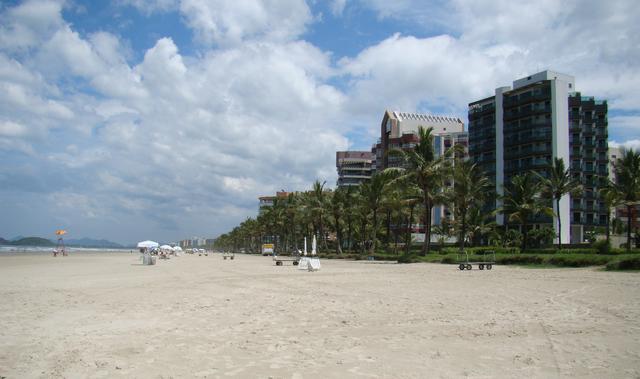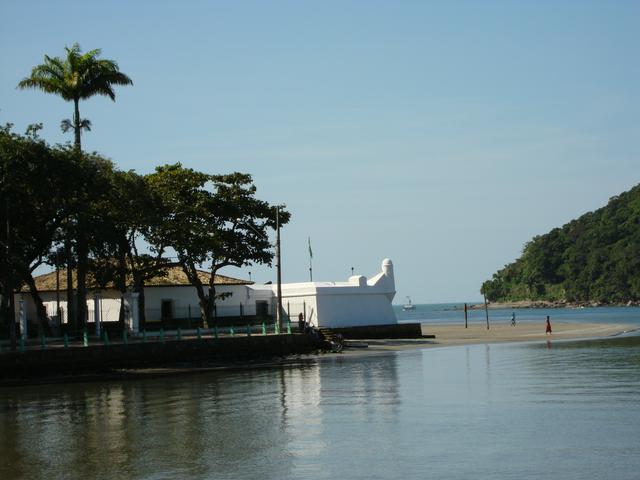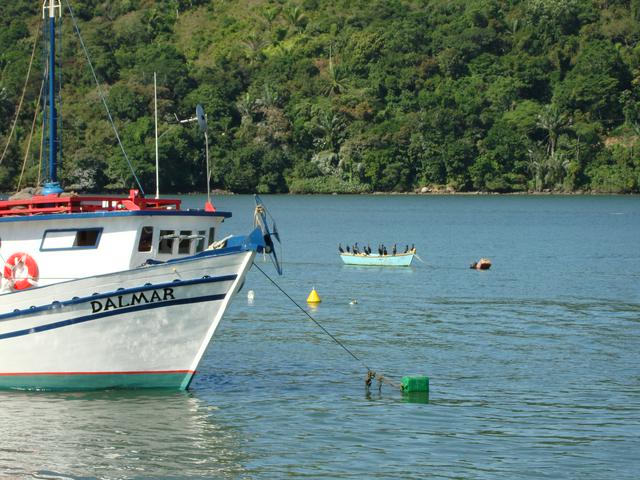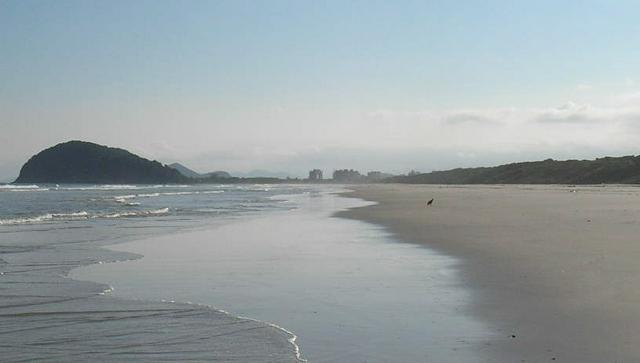
Bertioga is a sea side town in São Paulo State. It is a former district of Santos and considered to be part of the Baixada Santista metro area, although it has no conurbation with other cities.
Although mainly a local tourism destination, Bertioga is an attractive day/weekend trip for international visitors to São Paulo, as it offers excellent beaches and has much less crime problems than the neighboring Guarujá.
Bertioga was initially populated by Native Brazilians of the Tupinambá and Tupiniquim tribes. The region is the scenario of the controversial book True Story and Description of a Country of Wild, Naked, Grim, Man-eating People in the New World written by the German mariner Hans Staden.
In 1532, Portuguese settlers founded there the oldest fortress of Brazil - Forte São João de Bertioga, which has been definitively completed only in 1702, and is until nowadays the most important landmark of the town.
Bertioga remained as a suburb and later as a district of Santos until 1991, when it became a separate municipality. Bertioga is obviously less famous than its neighboring coastal towns - Guarujá and São Sebastião, and despite being now a "city on its own", it retains the feel of a collection of coastal suburbs (even downtown looks like an ordinary suburb). However, Bertioga is still an important local tourism destination of the São Paulo state, with many Paulistas keeping summer vacation houses in the town.

- Aldeia Rio Silveira, +55 13 3317-3567. Appointment only. Rio Silveira is an indigenous village close to the Boracéia beach, an heritage of Bertioga's Native Brazilian past. The village is inhabited by about 400 Native Brazilians and can be visited under appointment.
- Itatinga village. Itatinga is a village built in the beginning of the XX century around the hydro-electrical power of the same name, which functions until nowadays. The ride to the village is an attraction by itself, as it includes a ferry boat crossing of the Itapanhaú river and a 7-km ride on an old tram. After seeing the historical houses, it is possible to take one of the trekking routes and enjoy the nature of Serra do Mar. Visiting is only possible through tourism agencies like Seivatur.
- Forte São João de Bertioga, +55 13 3317-4128. The oldest fortress of Brazil, constructed by Portuguese settlers to defend the Bertioga channel from both Native Brazilians and French pirates. Contains expositions of XVI century weapons and indigenous culture and artifacts, including drawings made by Hans Staden.

The beaches of Bertioga are similar to each other, differing only by their surroundings. They are mostly long in extension and broad in width. They have flat and somewhat hard sands.
- São Lourenço, Riviera neighborhood. Bertioga's most famous and affluent beach, surrounded by palm trees, upper class apartments (the Riviera neighborhood) and having good tourist infrastructure. Good for both surfing and swimming, but the sea can get violent sometimes. A bit like the more famous Maresias beach in São Sebastião, it attracts younger crowds and has expressive nightlife.
- Enseada. Long beach with 12 km, it is polluted in the west side (at downtown) but clean in the east side (at Indaiá).
- Guaratuba. Long and quiet beach, with few houses and a lot of forest around. Not much infrastructure either.
- Boracéia. More crowded than Guaratuba due to the presence of a large gated community nearby. It contains some kiosks and camping facilities.
- Itaguaré. Semidesert beach completely surrounded by preserved rainforest. It attracts surfers due to its strong waves. It can be accessed by car or by walking from the east of the São Lourenço beach.
São Lourenço, Riviera neighborhood. Bertioga's most famous and affluent beach, surrounded by palm trees, upper class apartments (the Riviera neighborhood) and having good tourist infrastructure. Good for both surfing and swimming, but the sea can get violent sometimes. A bit like the more famous Maresias beach in [[São Sebastião]], it attracts younger crowds and has expressive nightlife.
Enseada. Long beach with 12 km, it is polluted in the west side (at downtown) but clean in the east side (at Indaiá).
Guaratuba. Long and quiet beach, with few houses and a lot of forest around. Not much infrastructure either.
Boracéia. More crowded than Guaratuba due to the presence of a large gated community nearby. It contains some kiosks and camping facilities.
Itaguaré. Semidesert beach completely surrounded by preserved rainforest. It attracts surfers due to its strong waves. It can be accessed by car or by walking from the east of the São Lourenço beach.
Aldeia Rio Silveira, +55 13 3317-3567. Appointment only. Rio Silveira is an indigenous village close to the Boracéia beach, an heritage of Bertioga's Native Brazilian past. The village is inhabited by about 400 Native Brazilians and can be visited under appointment.
Itatinga village. Itatinga is a village built in the beginning of the XX century around the hydro-electrical power of the same name, which functions until nowadays. The ride to the village is an attraction by itself, as it includes a ferry boat crossing of the Itapanhaú river and a 7-km ride on an old tram. After seeing the historical houses, it is possible to take one of the trekking routes and enjoy the nature of Serra do Mar. Visiting is only possible through tourism agencies like Seivatur.
Forte São João de Bertioga, +55 13 3317-4128. The oldest fortress of Brazil, constructed by Portuguese settlers to defend the Bertioga channel from both Native Brazilians and French pirates. Contains expositions of XVI century weapons and indigenous culture and artifacts, including drawings made by Hans Staden.

- The flat sands of Bertioga's beaches make them perfect for jogging, playing football, and bringing small children to play close to the water
- For surfing, Bertioga isn't on par with São Sebastião or Ubatuba, but it sometimes hosts regional competitions. The best waves can be found at Itaguaré and São Lourenço (close to the pier and on the left corner). For beginners, a number of surf schools can also be found in the town.
For surfing, Bertioga isn't on par with São Sebastião or [[Ubatuba]], but it sometimes hosts regional competitions. The best waves can be found at Itaguaré and São Lourenço (close to the pier and on the left corner). For beginners, a number of surf schools can also be found in the town.
In Saturday morning street market (in the broad inland avenue) apart from local small farmers, you may see a couple of Guarani Indians selling hand made goods. Just up the channel from the ferry jetty, local fishermen sell their shrimps and fresh fish.
- Shopping Riviera, Av. da Riviera, 1256 - Riviera, +55 13 3316-6033. It is considered to be the largest shopping mall of the São Paulo North Coast, although it has only about 50 shops. Heavily focused on "vacation stay needs", but it also hosts an entertainment area, and on weekends, expositions and musical concerts.
Shopping Riviera, Av. da Riviera, 1256 - Riviera, +55 13 3316-6033. It is considered to be the largest shopping mall of the São Paulo North Coast, although it has only about 50 shops. Heavily focused on "vacation stay needs", but it also hosts an entertainment area, and on weekends, expositions and musical concerts.
Apart from very fresh shrimps and fish everywhere, several Spanish owned simple restaurants serve quite good paellas
- Maremonti, Largo dos Coqueiros, 15 - Riviera, +55 13 3316-7508. Italian food.
Maremonti, Largo dos Coqueiros, 15 - Riviera, +55 13 3316-7508. Italian food.
- Pucci Riviera, Av. Marginal, 329 - Riviera, +55 11 3167-2067. Club that hosts pre-arranged parties during weekends. Most parties will happen during high season.
Pucci Riviera, Av. Marginal, 329 - Riviera, +55 11 3167-2067. Club that hosts pre-arranged parties during weekends. Most parties will happen during high season.
Bertioga has one of the lowest crime rates of the São Paulo coast, making it an excellent option for tourists who want to have a relief of the tension of São Paulo, Santos and Guarujá.
